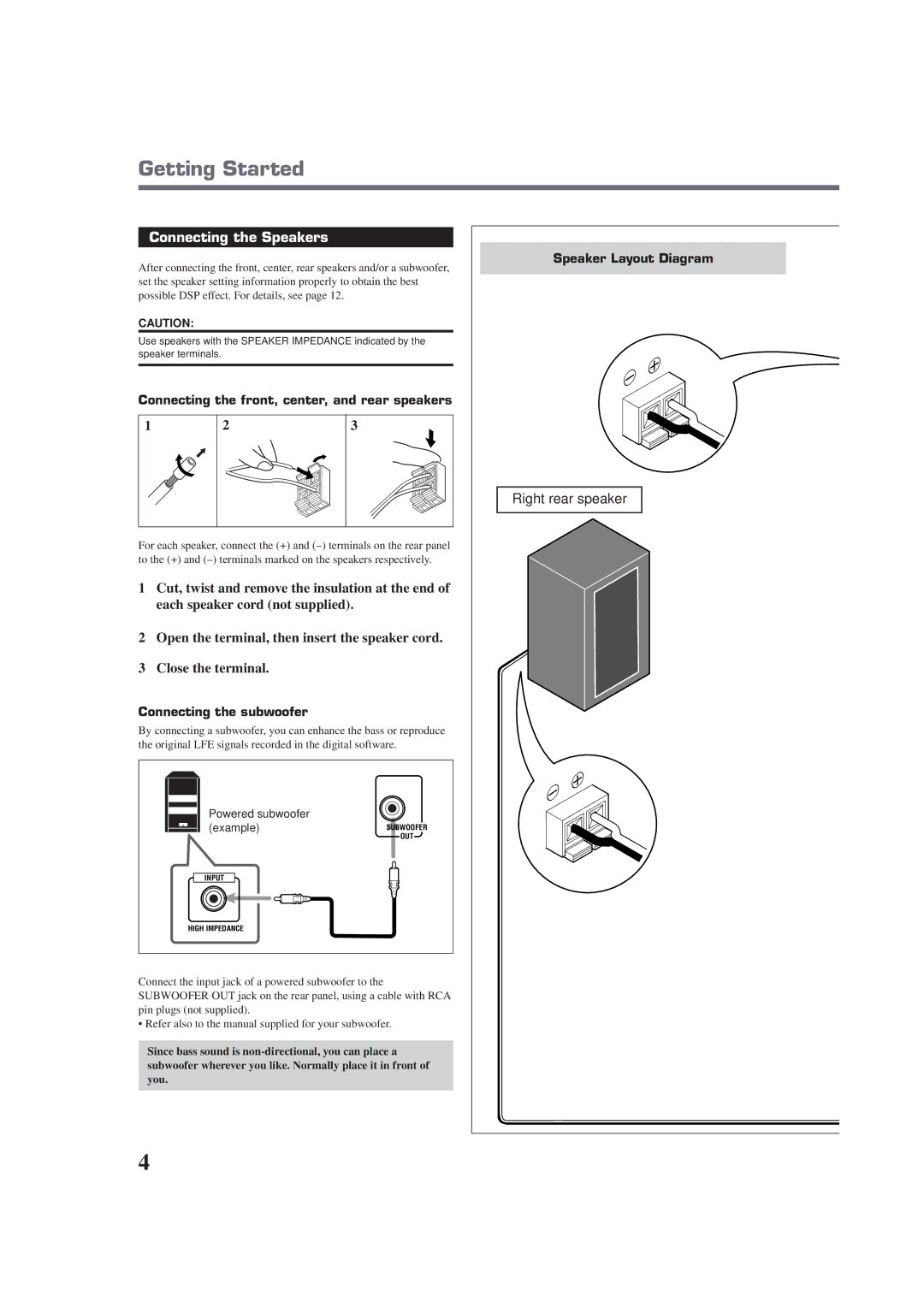RX-E100SL
For Canada/pour Le Canada
Table of Contents
Checking the Supplied Accessories
Before Installation
Putting Batteries in the Remote Control
Getting Started
Started
Connecting the FM and AM Antennas
Getting
AM antenna connection
Connecting the front, center, and rear speakers
Connecting the Speakers
Speaker Layout Diagram
Connecting the subwoofer
Left front speaker
Connecting cords are not supplied with this unit. Use
Connecting Audio/Video Components
Connecting the Power Cord
Digital connections
DVD
To increase the volume, press and hold
Turn On the Power
To turn off the power into standby
To decrease the volume, press and hold
Turning Off the Power
With the Timer
Basic Operations
Press Setting
Basic Settings
Setting the Digital Input
Terminals
Basic Settings
Selecting the Analog or Digital Input Mode
When Dgtl D.D. or Dgtl DTS is selected, Auto goes off
DSP Modes
Setting the Subwoofer Information
Setting the Speakers for
Press Control 3or 2 to select YES
Press Control 3 or 2 to select the appropriate speaker size
Delay Time CTR DL, Rear DL
Ex. When registering the rear speaker size
Display
Ex. When adjusting the center delay
Press Control 3or 2 to select the delay time
Repeat steps 2 and 3 to adjust the other delay time
Crossover Frequency Cross
Press Control 3or 2 to select the LFE attenuator level
Dynamic Range Compression D.R.C
Low Frequency Effect Attenuator LFE
To activate Auto Surround, follow the procedure below
Setting Auto Surround
To cancel Auto Surround
Each time you press the button, Auto Surround turns on or
Attenuating the Input Signal
Sound Adjustments
Basic Settings/Sound Adjustments
Adjusting the Front Speaker
When using the remote control
Reinforcing the Bass
Press Control 3 or 2 to turn on or OFF Bass Boost
Sound Adjustments
Adjusting the Tone
Adjusting the Subwoofer Output Level
Tuner Operations
Tuning in Stations Manually
Using Preset Tuning
Press FM or AM to select the band
To restore the stereo effect
Selecting the FM Reception Mode
To tune in a preset station
Tuner Operations
Creating Realistic Sound Fields
DAP Digital Acoustic Processor Modes
Available DSP modes according to the input signal format
Creating Realistic Sound Fields
Creating sound field
When Auto SR Auto Surround is turned on
Surround mode
DSP mode
About Relations between Speaker Layout and DSP Modes
Using Surround Modes Remote Control
Press Test to check the speaker output balance
Adjust the following speaker output levels from -10 to +10
Using Theater Surround Remote Control
Press Test again to stop the test tone
To cancel Theater Surround
Press Effect to select the DSP effect level 1 to You want
Using DAP Modes Remote Control
Adjust the rear speaker output levels from -10 to +10
To cancel DAP Mode
Digital, or DTS Digital Surround
Using Surround Modes Front Panel
Press Surround ON/OFF to activate an
See
Using Theater Surround Front Panel
Press Control 3or 2 to adjust the speaker output level
Ex. When adjusting the center speaker output level
Using DAP Modes Front Panel
Press Control 3or 2 to make an adjustment
Repeat steps 4 and 5 to make other adjustments
Ex. When adjusting the left rear speaker output level
Mastering Remote Operations
Mastering Remote Operations
Operating other JVC products Audio/video operation buttons
Remote Control
Parts Identification
Front Panel
Troubleshooting
Parts Identification/Troubleshooting
FM tuner IHF
Specifications
Amplifier
AM tuner
Memorandum
Source Name
781 954 650
Valley Road Wayne, NJ
1099
Limited Warranty AUDIO-2
0301NHMMDWJEIN

